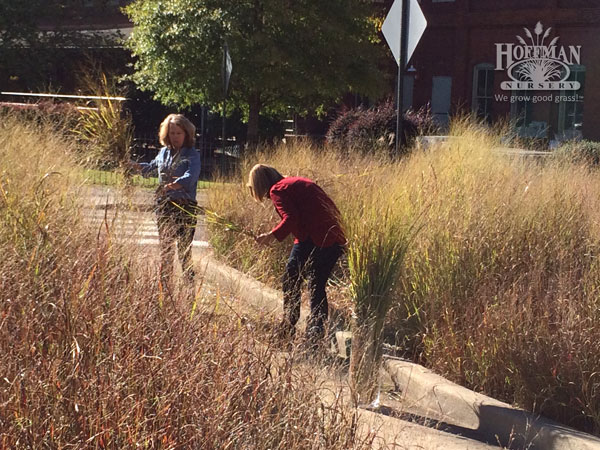We spent several days learning more about the world of stormwater. The Southeast Stormwater Association held their annual conference this year in Chattanooga, Tennessee, and Shannon attended. You may wonder why we’re interested in stormwater, but it’s a natural fit. We’ve long emphasized the functional benefits of grasses and sedges, and we continue to see an increase in requests for plants for green infrastructure projects. In this context, stormwater comes up a lot.
Many communities are encouraging developers to put in bioretention cells, stormwater wetlands, and bioswales to manage stormwater. These kinds of features have benefits beyond handling stormwater—they support wildlife, increase biodiversity, and can be an amenity for the community.
Green Infrastructure in Action
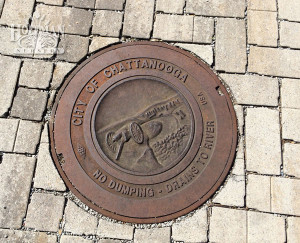 Located in eastern Tennessee, Chattanooga is a beautiful city that’s growing rapidly. The Tennessee River runs through the middle of the city, so runoff from stormwater winds up in the river. According to the city’s Water Quality Program website, the new program, “supports the mindset that stormwater is not a nuisance, but a resource.”
Located in eastern Tennessee, Chattanooga is a beautiful city that’s growing rapidly. The Tennessee River runs through the middle of the city, so runoff from stormwater winds up in the river. According to the city’s Water Quality Program website, the new program, “supports the mindset that stormwater is not a nuisance, but a resource.”
The city has enacted ordinances that encourage new and redeveloped sites to capture increased amounts of stormwater onsite. This helps rainfall infiltrate the ground and treats it before it reaches the river. The new ordinances use financial incentives, such as reducing stormwater fees when developers and owners use green infrastructure.
Touring the City
The conference included a tour of sites that highlight the city’s stormwater program. The tour began with a commercial development that had been built decades ago as a multi-screen theatre with parking. It was converted to an office complex, and all that parking was no longer needed. However, the huge expanse of impervious surface generated a tremendous amount of runoff. That also meant high stormwater fees.
Under the city’s new system, however, the owner reduced his fees by 80% by creating a constructed wetland to manage stormwater. Most of the land that was converted to wetland lies in a utility easement, so it was unusable for development. The wetland project has changed the owner’s mind about the city’s new stormwater program. While initially opposed, he has become a convert.
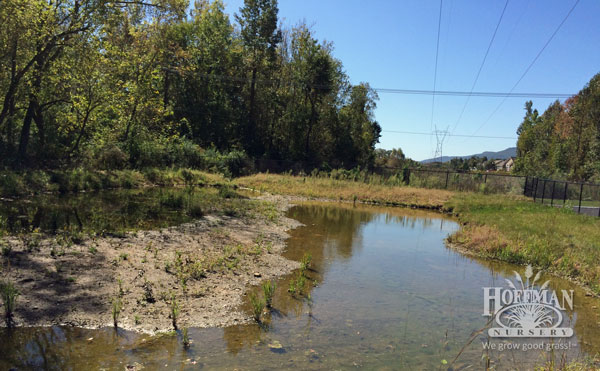
On another site, a neighborhood school has installed a rain garden, permeable paving, and a cistern. With the city’s help, they turned a soppy, perpetually flooded athletic field into a safe and well-maintained recreation area. The rain garden captures and cleans runoff from a portion of the parking lot. Permeable pavement at the base of a hill also captures water and delivers it to a cistern. The cistern stores the water for irrigating the athletic fields.

As the city grows, there are more opportunities for incorporating plants into the urban landscape. Several sites near the conference hotel featured beautiful grass plantings, which we loved seeing.


Going Green in the Southeast
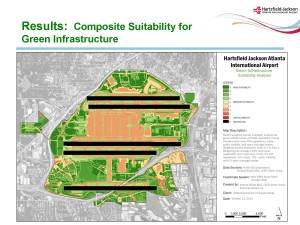
Most of the conference talks focused heavily on the engineering side of stormwater. However, a number featured green infrastructure, which suggests this approach is gaining steam in the Southeast. A horse park in Kentucky is using bioretention to treat horse muck and protect the local watershed. Hartsfield-Jackson Airport in Atlanta recently finished a study looking at land suitability for green infrastructure at their site.
A presentation on regenerative stormwater conveyances (RSCs) showed how this relatively new feature combines the benefits of bioretention and swales. RSCs allow for infiltration and treatment while controlling water movement in tight areas. An engineering consulting firm showed several successful installations in North and South Carolina.
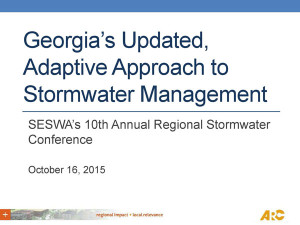 At the policy level, Georgia has updated their stormwater manual. The original manual was written 15 years ago, and approaches to stormwater have changed. The focus is now on retaining and treating stormwater runoff, rather than simply moving it out of the way. Communities are encouraged to use green infrastructure, low impact development and better site design. The manual includes examples from existing sites to help communities see the benefits of incorporating these approaches.
At the policy level, Georgia has updated their stormwater manual. The original manual was written 15 years ago, and approaches to stormwater have changed. The focus is now on retaining and treating stormwater runoff, rather than simply moving it out of the way. Communities are encouraged to use green infrastructure, low impact development and better site design. The manual includes examples from existing sites to help communities see the benefits of incorporating these approaches.
Reason for Optimism
After hearing about Chattanooga’s progressive approach and projects in the Southeast that use green infrastructure, we think it’s great news for the green industry. More plants and plant expertise will be needed. Growers are uniquely positioned to provide both, and we’re working to make those connections and get involved. And we appreciate clean water, too!
